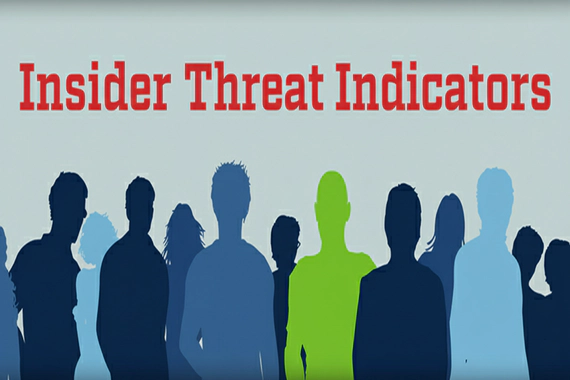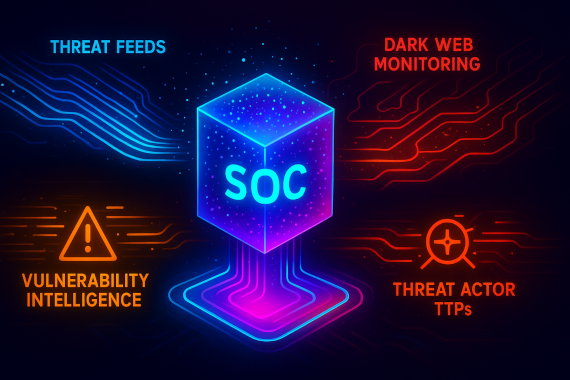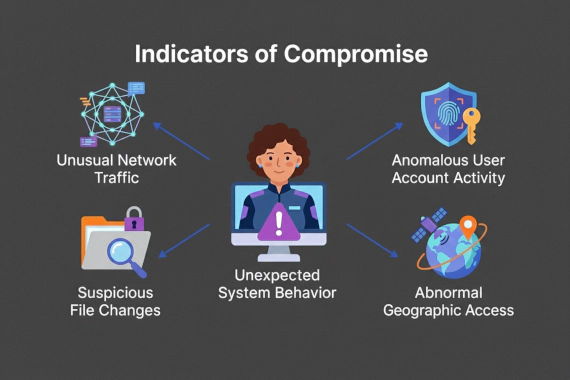
Insider Threat Indicators: How to Detect Internal Risks
Insider Threat Threat Intelligence Data Breach Prevention Security Operations
What Are Insider Threat Indicators? Security teams spend billions on perimeter defenses. Firewalls. EDR. Network …

Learn how external threat intelligence catches attackers before they breach your network.
• External threat intelligence warns you about attacks before they happen, while internal tools only see what’s already gotten through.
• Sources include OSINT feeds, commercial vendors, dark web monitoring, and government data sharing that internal tools can’t access.
• Most organizations drown in threat data because they subscribe to everything instead of filtering for relevant intelligence.
• Success requires integration with internal security tools, not treating external intelligence as a standalone product.
90% of organizations use external threat intelligence sources. Yet only 41% have formal plans for what intelligence to collect and how to use it (SANS 2025 CTI Survey). They’re collecting millions of indicators of compromise, subscribing to 15 threat feeds, and accomplishing nothing except overwhelming their security teams.
Here’s the problem. The threat intelligence industry sells external feeds as the solution to every security problem. Reality check: external threat intelligence is worthless without internal context. A list of 10,000 malicious IPs means nothing if none of them are trying to attack YOUR infrastructure.
The Snowflake breach exposed this gap. Stolen credentials were circulating on dark web forums for weeks before the attack. External threat intelligence could have detected those compromised credentials. But organizations failed to correlate external intelligence about stolen credentials with their internal user accounts. The intelligence was there. The integration wasn’t.
External threat intelligence isn’t broken. How organizations use it is broken. Here’s how to fix it.
External threat intelligence is threat data collected from outside your organization that provides context about attackers, their tactics, and risks to your environment before they successfully breach your network.
External threat intelligence is threat data collected from sources outside your organization that identifies attackers, their methods, and your exposure before they breach your environment.
The difference between internal and external threat intelligence comes down to visibility. Internal threat intelligence analyzes what’s happening inside your network. Your firewall logs show blocked connection attempts. Your SIEM alerts on suspicious authentication patterns. Your endpoint detection tools flag malware execution.
That’s reactive intelligence. You learn about threats after they interact with your environment.
External threat intelligence is proactive. It shows you threats heading your direction before they knock on your door. Stolen credentials for sale on dark web forums before attackers use them. Threat actors discussing which companies they’re targeting next. Zero-day vulnerabilities circulating in underground exploit marketplaces before vendors release patches.
Here’s the catch. 64% of organizations use internal threat intelligence sources while 90% use external sources (SANS 2025 CTI Survey). Why the gap? Because internal-only visibility is incomplete.
Your internal logs can’t show you:
Your internal logs can’t tell you when law enforcement discovers your breach before you do. Internal detection has blind spots that external threat intelligence fills.
External threat intelligence fills the gaps internal tools can’t see. But here’s what vendors won’t tell you: external intelligence without internal context is just expensive noise. We’ll get to that.
Now that you understand what external threat intelligence is and how it differs from internal intelligence, let’s break down the key components that make external threat intelligence actionable.
External threat intelligence includes five core components. Each serves a different purpose in your security operations.
Indicators of Compromise (IOCs)
Indicators of Compromise (IOCs) are digital artifacts like IP addresses, domains, file hashes, and URLs that indicate malicious activity or a security breach.
Reality check: most IOCs have a shelf life measured in hours or days. Organizations drowning in IOC feeds collect millions of indicators that were relevant yesterday but worthless today. Prioritize IOCs relevant to YOUR threat profile, not every IOC in existence.
Tactics, Techniques, and Procedures (TTPs)
HOW attackers operate, mapped to MITRE ATT&CK. TTPs matter more than IOCs because attackers rotate through dozens of IPs weekly but use the same lateral movement techniques for months.
Threat Actor Intelligence
Attribution reveals adversary motivation and typical targets. When you know Royal ransomware targets manufacturing via VPN vulnerabilities, you prioritize patching VPN infrastructure.
Vulnerability Intelligence
This includes information about software vulnerabilities, exploits in the wild, and patch availability. It’s critical for zero-day vulnerabilities where you can’t discover the flaw internally until vendors disclose it.
External threat intelligence tells you which CVEs are actively exploited, which have proof-of-concept code published, and which exploits are being sold on dark web marketplaces. That shifts vulnerability management from “patch by CVSS score” to “patch by actual risk.”
Dark Web and Underground Forum Intelligence
This covers stolen credentials, data leaks, exploit sales, and ransomware negotiations. Your internal security tools can’t monitor criminal forums. You lack the specialized access, infrastructure, and operational security required.
This is where Change Healthcare’s 2024 breach could have been prevented. Attackers used stolen credentials to bypass SSO protections. Those credentials, obtained through infostealer malware, were sold on dark web forums. External dark web monitoring would have flagged that exposure before attackers exploited it.
RECOMMENDED READING: Digital Risk Monitoring Guide
The question becomes: where does all this external threat intelligence actually come from?
These components don’t appear out of thin air. Here’s where external threat intelligence actually comes from and what makes each source valuable.
External threat intelligence comes from four primary categories. Each has different strengths, weaknesses, and use cases.
Open Source Intelligence (OSINT)
Public feeds like Shadowserver, MISP, AlienVault OTX, Abuse.ch, and URLhaus share IOCs and threat data. Advantage: free or low-cost. Limitation: variable quality and high false positives without filtering. Look for active community validation and STIX/TAXII formats for integration.
Commercial Threat Intelligence Feeds
Premium intelligence from vendors like Breachsense, Recorded Future, and Mandiant. Higher fidelity, lower false positives, dedicated analyst support. Cost: $50K-$500K+ annually. Look for confidence scoring, threat actor attribution, industry-specific intelligence, and MITRE ATT&CK mapping.
Dark Web Monitoring Services
Specialized monitoring of dark web marketplaces, forums, and leak sites. Detects credential exposure before exploitation, tracks threat actor communications, monitors exploit sales. Requires specialized infrastructure, forum access, language expertise, and operational security. Look for real-time alerting, credential monitoring across paste sites, and executive monitoring for C-level accounts.
Government and Industry Sharing
CISA, FBI, ISACs, and CERTs provide classified intelligence, industry-specific alerts, and critical infrastructure guidance. Often slower than commercial sources but includes sensitive intelligence unavailable commercially.
Threat Intelligence Platforms (TIPs)
TIPs aggregate and normalize multiple sources. 72% of organizations use TIPs to manage intelligence overload (SANS 2025 CTI Survey).
TIPs like Anomali, ThreatConnect, and MISP take feeds from OSINT, commercial vendors, dark web monitoring, and government sources, then provide unified interfaces, confidence scoring, automated enrichment, and integration with your security stack.
The fix for information overload isn’t more sources. It’s ruthlessly filtering external intelligence through TIPs configured for YOUR environment, YOUR industry, and YOUR threat profile.
With all these external sources available, the critical question is: why invest in external intelligence when you already have internal security tools monitoring your environment?
Internal security tools are necessary but insufficient. Here are five reasons external threat intelligence is non-negotiable.
You Can’t Discover Threats You’ve Never Seen
Your internal logs only show attacks that HIT you. External threat intelligence shows attacks HEADING TOWARD you.
Example: Black Basta ransomware actively targets manufacturing companies through stolen credentials and RDP access. External intelligence tells you that BEFORE they compromise your environment. Internal logs tell you AFTER they’re already inside.
57% of organizations in 2024 learned about compromises from external sources (M-Trends 2025). More than half of breaches were discovered by someone outside the organization, not internal security tools. That’s not a detection problem. That’s a visibility gap.
Threat Actors Don’t Respect Organizational Boundaries
Attackers who breached your competitor last week will try the same tactics on you this week. External intelligence lets you learn from other organizations’ pain without experiencing your own breach.
Third-party breaches account for 30% of all incidents (2025 DBIR). That stat doubled from previous years. If your vendor gets compromised, external threat intelligence about supply chain attacks is your early warning system.
The Blue Yonder breach in November 2024 demonstrated this. When the supply chain software provider was hit with ransomware, over 3.5 million businesses were at risk through the extended supply chain. Starbucks had to use pen and paper for employee scheduling across 11,000 stores. Sainsbury’s, Morrisons, and P&G all scrambled with manual workarounds. Your internal security tools can’t warn you when your critical vendor gets compromised.
Internal Tools Have Blind Spots
Your SIEM sees network traffic YOU control. Your EDR monitors endpoints YOU manage. Your firewalls inspect applications YOU run.
What internal tools DON’T see:
Internal-only visibility is incomplete by definition. That’s why organizations increasingly rely on external sources to fill the gaps their internal tools can’t see.
Speed Matters
Median dwell time globally: 11 days (M-Trends 2025). That’s how long attackers operate inside environments before detection.
External threat intelligence shrinks that window by alerting you when:
Every day of dwell time increases breach costs. External threat intelligence provides earlier detection than internal tools alone.
Executive Communication Requires Business Context
The board doesn’t care about IPs and hashes. They care about business risk, financial impact, and regulatory exposure.
External threat intelligence provides that context. Industry threat landscape reports translate technical threats into business language (68% of organizations now produce these reports according to SANS 2025 CTI Survey). Competitor breach analysis shows what happens to similar organizations. Financial impact projections quantify risk (average breach cost: $4.88M according to IBM 2025).
When you tell executives “third-party breaches doubled to 30% of all incidents,” that justifies vendor security requirements and supply chain risk programs. When you show them stolen credentials from infostealer malware hitting your industry, that justifies credential monitoring investments.
Internal threat intelligence tells you what happened inside your network. External threat intelligence tells you what’s happening across your industry, your threat landscape, and your business risk exposure.
Understanding why you need external threat intelligence is one thing. Seeing how mature organizations actually use it day-to-day is another. Here are the most common use cases driving ROI.
Threat Hunting
84% of organizations cite threat hunting as their top CTI use case (SANS 2025 CTI Survey). External intelligence enables hypothesis-driven hunting: query internal logs for known-bad IPs and domains from external feeds, hunt for MITRE ATT&CK techniques used by threat actors targeting your industry.
Incident Response
External intelligence answers questions internal logs can’t: Who’s behind this attack? What will they do next? How do we stop them? Threat actor attribution and TTPs from external feeds transform raw detections into informed response.
Vulnerability Prioritization
Your scanner finds 10,000 CVEs. External intelligence tells you which ones are actively exploited in the wild, which have published exploits, and which appear on dark web marketplaces. Patch by actual threat landscape, not just severity scores.
Third-Party Risk
When Blue Yonder’s supply chain software was compromised in November 2024, over 3.5 million businesses were at risk. External threat intelligence monitors vendor security posture, dark web mentions, and third-party breach indicators before they cascade to your operations.
Once you know how you’ll use external threat intelligence, the next critical decision is: should you build this capability in-house or buy from a provider?
Build: Hire analysts ($300K-$800K annually in salaries alone for 3-5 people, plus tools and infrastructure), subscribe to raw feeds, develop custom infrastructure. Makes sense for Fortune 500, critical infrastructure, highly sensitive industries. Takes 12-18 months to become effective.
Buy: Subscribe to commercial platforms ($50K-$500K+ annually). Operational within days. Makes sense for most organizations that need immediate capabilities without hiring specialized talent.
Hybrid (most common): External provider handles collection, dark web monitoring, and enrichment. Internal team contextualizes for your environment and integrates with security tools. Small organizations buy with one internal analyst. Mid-size and large organizations balance external providers with growing internal capabilities.
Bottom line: For most organizations, buy or hybrid makes more sense than pure build. Only build in-house if you have substantial budget, time, specialized expertise, and unique requirements that commercial providers can’t address.
Whether you build, buy, or use a hybrid approach, success depends entirely on integration. Here’s how to integrate external threat intelligence with your existing security stack and overcome the challenges that kill most implementations.
72% of organizations use threat intelligence platforms, yet most organizations still face integration challenges (SANS 2025 CTI Survey). The problem: external threat intelligence that lives in a separate dashboard is external threat intelligence that doesn’t get used.
Integration determines ROI. Here’s how to do it right.
Key Integration Points
SIEM: Ingest threat feeds via STIX/TAXII connectors. Create correlation rules (“alert if internal IP communicates with known-bad external IP”). Enrich alerts with threat actor attribution and TTPs.
SOAR: Automate IOC blocking across firewalls and EDR. Build playbooks: when external feed alerts on new ransomware IOCs, automatically search internal environment, isolate affected systems if found, or add to block lists preventatively.
EDR: Enable automatic IOC hunting across endpoints. Build custom detection rules based on MITRE ATT&CK mappings from external intelligence.
Vulnerability Management: Prioritize CVEs based on active exploitation intelligence rather than CVSS scores alone.
Tune, Filter, and Provide Feedback
Most external threat intelligence is irrelevant to your specific environment. Ruthlessly filter: disable irrelevant feeds, filter by confidence score, geofence by region, prioritize industry-specific threats.
Provide feedback to vendors: report true positives, false positives, and intelligence gaps. This improves feed quality and enables measurement.
Common Integration Challenges
Information Overload: Only 41% of organizations have a formal structured plan for collecting threat intel (SANS 2025 CTI Survey). Most teams collect everything instead of defining what actually matters. Fix: Define requirements first, ruthlessly filter by confidence score, geolocation, and industry vertical before data reaches analysts.
False Positives: Security teams spend 25% of their time on false positives (Ponemon Institute). Fix: Expire IOCs older than 30-90 days, only alert on high-confidence threats, correlate multiple indicators before alerting, implement allowlists for known-good infrastructure.
Measuring Effectiveness: Only 55% of organizations measure CTI effectiveness (SANS 2025 CTI Survey).
The fix: Define success metrics upfront before deploying external intelligence. Track operational metrics (threats detected via external intelligence, false positive rates, mean time to detect improvements, mean time to respond improvements). Track strategic metrics (breach prevention, cost avoidance, risk reduction). Survey stakeholders. Benchmark against industry averages.
The goal: Shift from “we have external threat intelligence” to “external threat intelligence reduced our risk by X%.”
Best Practices Summary
Start small with one tool and one high-quality feed before expanding. Automate integration because manual processes don’t scale. Monitor integration health by tracking feed ingestion rates and API errors. Document playbooks for how analysts should respond when external threat intelligence triggers alerts. Train your team because external intelligence is useless if analysts don’t know how to interpret it. Measure value by tracking metrics like threats detected via external intelligence versus internal tools alone.
The fix for most organizations isn’t more external threat intelligence sources. It’s better integration of the sources you already have, ruthless filtering to eliminate irrelevant data, and continuous tuning based on what actually prevents breaches in YOUR environment.
External threat intelligence is the difference between knowing an IP is bad and knowing it’s Akira ransomware targeting your industry via phishing campaigns with specific remediation steps. It’s threat data collected from outside your organization (dark web forums, threat feeds, researcher reports) that provides context about attackers, their methods, and your exposure before they breach your environment.
The four primary sources are: open-source intelligence (OSINT) from public feeds and forums, commercial threat intelligence providers with dedicated research teams, dark web monitoring services that track stolen credentials and data leaks and government/industry sharing organizations like ISACs and CERTS. Most mature organizations use a mix of all four rather than relying on a single source.
Internal threat intelligence analyzes what’s happening INSIDE your environment (firewall logs, SIEM alerts, endpoint data) while external threat intelligence shows threats HEADING TOWARD you from outside sources before they hit. Think of internal as your security cameras showing who broke in, while external is the neighborhood watch warning you about burglars operating in your area. You need both.
Internal tools only detect threats they’ve seen before or that match known signatures. They completely miss zero-day exploits, stolen credentials circulating on dark web forums before use (like the Snowflake breach), threat actors planning attacks against your industry, and vulnerabilities in your tech stack before vendors disclose them. That’s why in 2024, 57% of organizations first learned about their breach from external sources, not internal tools (M-Trends 2025).
Buy or use a hybrid approach unless you’re a large enterprise with $500K+ security budget and ability to hire specialized analysts. Building in-house costs $250K-$750K annually just for analyst salaries plus tools, takes 12-18 months to become effective, and requires rare talent you’ll struggle to recruit. Commercial services provide immediate capabilities for $50K-$300K annually.

Insider Threat Threat Intelligence Data Breach Prevention Security Operations
What Are Insider Threat Indicators? Security teams spend billions on perimeter defenses. Firewalls. EDR. Network …

Indicators of Compromise IOC Threat Intelligence Dark Web Monitoring Cybersecurity Breach Detection
IOCs work. But they work after the fact. By the time you find a malicious file hash or C2 beacon, attackers have already …